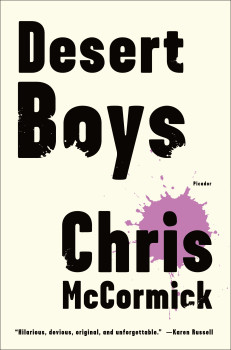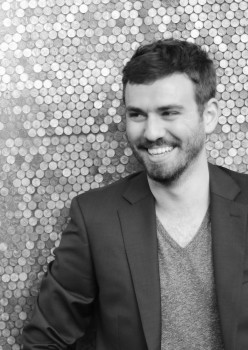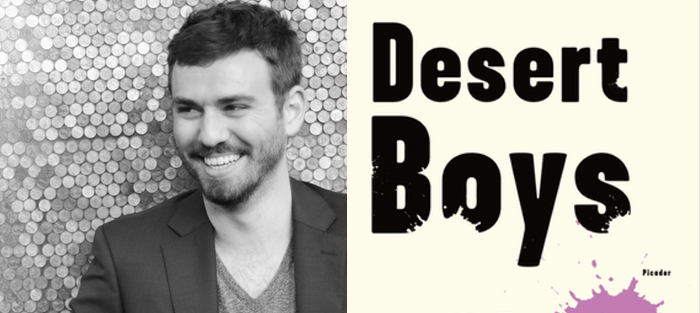In “Shelter,” the final story of Desert Boys, two young boys are playing video games when one makes a prophecy.
Karinger paused the game and looked at me. The random yellow hairs on his face had multiplied since the morning. “You’re going to leave too,” he said. “I can see it in your face. One by one, I’m going to watch everyone leave this place, aren’t I?”
“You can leave, too,” I said. “Don’t you want to?”
This place is the Antelope Valley in California, the western point of the Mojave Desert star, between the San Gabriel and Tehechapi Mountains, home of the Antelope Valley California Poppy Reserve. It’s also home to acres upon acres of tract homes, strip malls, aquifers, and golf courses. When Daley Kushner, who often narrates these linked stories, leaves the Antelope Valley, he can’t stop thinking about the place and the people still there. In another story, Kush, as he’s known to his friends, realizes, “…this was why I’d never been interested in politics: I wanted to understand the past while everyone else wanted to talk about the future. I felt tired.”
Through stories told by and about Kush, Karinger, and Watts (the “boys”), as well as the people around them, Desert Boys asks: who we are when we leave a place? How much of it we must carry with us? And, more than that, who are we when we go back home?
Chris McCormick is a graduate of UC Berkely and the Helen Zell Writers Program at the University of Michigan. His essay “Armenian Exceptionalism,” about his uncle’s art studio in Glendale, California, and the Armenian community there, recently appeared in The Atlantic. McCormick will launch Desert Boys with a reading in Ann Arbor on May 4th, which will be followed by several tour dates on the west coast later this month. For more information about these events, visit his website. You can also follow him on twitter.
Interview:
 Rebecca Scherm: I found myself thinking of your collection as a writer’s ethnography of the Antelope Valley, partly experienced, partly in stories passed down, and partly imagined. Did you have ethnography in mind?
Rebecca Scherm: I found myself thinking of your collection as a writer’s ethnography of the Antelope Valley, partly experienced, partly in stories passed down, and partly imagined. Did you have ethnography in mind?
Chris McCormick: In a way, yes, because I knew it was a gift to be a writer from such an underrepresented place, and I wanted to get it right from the perspectives of those who call it home. And our ideas of home are always a combination of history, personal experience, other people’s stories, and our imaginations, so I wanted to include all of that in one way or another. But my first attempts were almost too ethnographic—they were detailing and explaining the place rather than asking questions about the place and trying to understand some deeper aspect of its character. There’s that great line by Grace Paley about writing what you don’t know about what you know—when I started doing that, the book became less scientific and more alive.
You’ve found a way, I think, by looking not directly at the place but instead in how its inhabitants react to it and are shaped by it.
And how they mythologize the place, too. When I said I wanted to “get the place right,” that’s not to say factually right, but texturally right. This is a mythologized Antelope Valley, but that’s not contradicting my goal of getting it right. In Southern California, the mythic often feels more “authentic” than any factual account ever could.
“The Tallest Trees in the Antelope Valley” reminded me of an episode of the 99% Invisible podcast about palm theft along the LA freeways. I hadn’t thought about palm trees as an adopted symbol of Southern California until I heard it—or about “Southern California” as an idea in opposition to the real, living place itself, including the Antelope Valley. Were those misconceptions one of your reasons for starting this project?
Definitely. There’s a line in the book about how un-California most of California is, which even certain Californians don’t seem to know or appreciate fully (Lloyd from this story, for example). Not only physiographically different than the popular image of California, but culturally and politically, too. The convenient thing for my writing was that just by virtue of being specific, it could help a reader’s misconceptions announce themselves, and I didn’t have to do much explicit pontificating. By being specific, I was deconstructing a myth. But I was also doing something else, which came as a surprise to me. I try to resist essentialism, but that’s one thing that feels deeply Californian to me, that you can’t break down one myth there without building another. Still, deconstructed or not, those pre-received images of California are powerful and shouldn’t be ignored. Think of the palm trees, non-native and transplanted just as the westward-bound settlers. A contrived image of Southern California, sure, and yet what could be more perfect?
 Kush is a careful character and a careful narrator—he is always minding his glances, managing his reactions. And Karinger is careful, too, in a way: he seems more “wild” but he is very disciplined, even as a kid. The paintball field is their reckless place, but even then, it’s controlled, and the paint washes off. It’s Watts who’s reckless, right? Is that how you see them?
Kush is a careful character and a careful narrator—he is always minding his glances, managing his reactions. And Karinger is careful, too, in a way: he seems more “wild” but he is very disciplined, even as a kid. The paintball field is their reckless place, but even then, it’s controlled, and the paint washes off. It’s Watts who’s reckless, right? Is that how you see them?
I think all three of the friends care about and respect rules—small ones like in golf and paintball, but big rules about who you’re allowed to love, too. More than who respects the rules, I’m interested in which of the boys tend to set the rules, and which tend to follow them, and why, and how that might change, and why an exception might be made. As for Watts, it’s interesting to think of the one boy who stays home as the reckless one, but I’m not convinced. One of his most “reckless” moments is when he rats on somebody for breaking the law. He breaks one “rule”—the golden rule of human compassion—to enforce a legal one he really doesn’t care that deeply about. But then, the world is filled with examples of people acting reckless and law-abiding all at once.
You’re right—I must still be clutching my pearls over the incident (spoiler alert!) with Watts and Roxanne in the bathroom. The power dynamic with these friends—who sets the rules, as you say—is where the texture is. But possibly I’m also reacting to the surprise of Watts breaking Karinger’s (implicit) rules in that story. Certainly Watts would not have feared Kush’s wrath had the girl in question been Jean!
What do you think Karinger would make of Kush, had Karinger lived? [A detail the reader learns at the start of the book.]
This is tough. Part of me thinks Karinger honestly loved Kush like a brother, and would have continued to need that love. Another part of me worries that Karinger enjoyed play-acting a kind of fatherhood he was missing in his own life, and wouldn’t have much use for a grown-up Kush. I hate to be so pessimistic about a person I created, but there’s no doubt that’s part of their dynamic. Hopefully forgiveness and tenderness and love would be parts of it, too.
In “How to Revise a Play,” we get to see around Kush’s perspective a little bit in how his father and Lloyd enjoy each other’s company so quickly and easily. Kush can’t handle it! They reject his perspective, in a way. There are other stories, too, where you find creative ways to get around Kush and give us another lens—”Habibi,” “My Uncle’s Tenant.” Why was this important to you?
It has a lot to do with how important place is in the book. For the Antelope Valley to come alive on the page, I wanted a variety of experiences there, from a variety of people. But they had to be tied, thematically, to Kush, because his voice and his questions about the AV make up the heart of the book. Sometimes, when Kush is being especially solipsistic and difficult to see around, I’ll have a character call him on it, crack him open so some light can shine through. Other times, it’s more structural. I followed the advice Kush’s father gives him early on, which is to be an excellent listener. Listening is just as crucial an act of storytelling as narration, and so in some stories Kush pulls his weight by becoming a conduit for other voices, other stories.
Which story came first, and where did it lead you?
I wrote “Shelter” (the penultimate story in the book) first, back in 2009. What I liked about it even in those early days was the dynamic between the two boys, one a seemingly comfortable indoor-kid with both parents at home, the other a fatherless desert-dweller. They seemed to have a natural son-father relationship, despite being the same age. I still can’t quite believe how that early dynamic ended up being the central one of the finished book.
Which of these stories was the biggest pain in the ass?
Ha. The opening story—”Mother, Godfather, Baby, Priest”—not only for its sheer length and all its moving parts, but also because that’s where Kush and Karinger stopped being just a dynamic, and started being specific human individuals (which sounds like the opening to The Real World). It’s a lot of work turning dynamics into people!
Did you write this collection story at a time, or did you work in layers, a few at time? Did you always know that they would be linked in this way?
One story at a time, and then all at once to fit them together. When I first started, I had the ostentatious but super-sincere hope to write the Dubliners of the Antelope Valley. So I had a more traditional, multi-voiced collection in mind, all set in the same place at the same time, with some characters popping up here and there to remind the reader of how clever I was. It was like Erdrich-lite. I’m grateful to my agent, Jenni Ferrari-Adler, for pointing to Kush and saying, here’s the heart, and the AV will beat through him.
 You wrote that “Habibi” was inspired by Chekhov’s “Gooseberries.” Can you talk about that idea and process?
You wrote that “Habibi” was inspired by Chekhov’s “Gooseberries.” Can you talk about that idea and process?
Chekhov knew that a story was more like a poem than like a novel, a whisper in the ear, a secret, a form naturally suited to loneliness and confession. He understood that short stories ended most memorably not by closing but by blooming. “Gooseberries” has interested me for a long time, especially structurally. The storm that traps our travelers, the story within a story, the rain beating against the window at the end—so many of its elements have now become tropes. Peter Ho Davies, my professor at the time, challenged me to try a rewrite of it, and I could immediately picture Kush and his sister trapped during a downpour in her adopted city of New York, nowhere to go but into the secret world of her history. I liked the idea of them in the rain, since it’s such a physical indicator that they’re far from home. Some of the language at the very start of “Habibi” is borrowed from Chekhov, but soon the specifics of my characters’ lives—the cake instead of the gooseberries, for instance—began to steamroll the source material. Then—to me, anyway—it felt like its own story, and I revised it as such, paying zero attention to Chekhov’s.
I’ve never “rewritten” a beloved story, and you’ve made me badly want to. But maybe a novel or a collection is just doing that on a large scale with the books we hold closest. When I’m writing a big project, I hold certain books in my mind that I believe will guide me through the specific project. I think of them as the book’s patron saints. Does Desert Boys have patron saints?
At the risk of sounding like I’m comparing my book to any of the following: classics like Dubliners and Winesburg, Ohio were on my mind, to be sure, and Love Medicine more than anything else, probably. Sula is the greatest portrait of both a friendship and a place over time, so I looked to that novel as a kind of model. And although I didn’t read Justin Torres’s gorgeous We the Animals until I’d already sold the book, no one will believe me so I might as well mention that here, too.
Ooh, I know that feeling well. Do you think that you’ll keep working “in” the Antelope Valley, or did the writing of Desert Boys answer your essential questions?
You know how questions can be hydras—you think you’ve solved one, and then two more sprout. I’m sure the desert will continue to baffle me in the future, but I’m excited to say my next book has more stamps in its passport.






